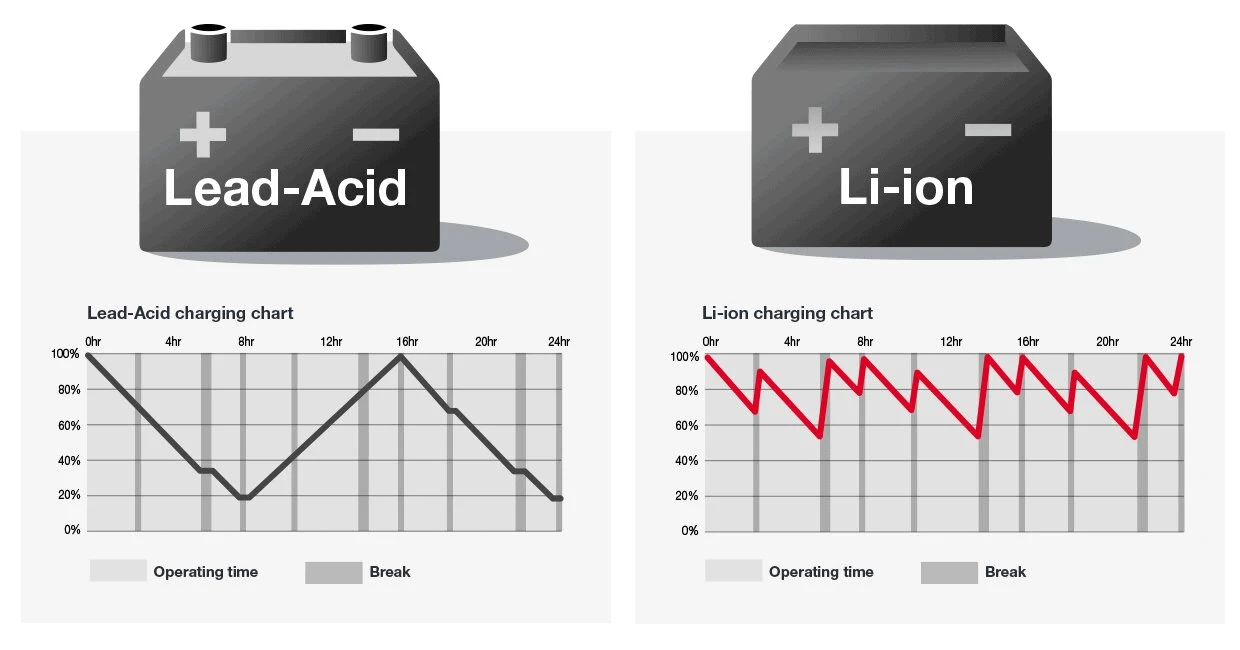
As industrial and commercial applications continue to evolve, the choice of battery technology plays a crucial role in operational efficiency. Lead-acid batteries and lithium iron phosphate (LiFePO4) batteries are two common power solutions, each with distinct charging requirements. Understanding these differences is essential for optimizing performance, especially in remote areas where charging infrastructure may be limited.
Application Scenarios of Lead-Acid and LiFePO4 Batteries
Lead-acid batteries have been widely used in industrial machinery, forklifts, golf carts, and backup power systems due to their low initial cost and established technology. However, they require a controlled charging environment and frequent maintenance, making them less convenient in demanding applications.
In contrast, LiFePO4 batteries are increasingly adopted for electric industrial vehicles, aerial work platforms, ground support equipment (GSE), cleaning machines, small boats, and RVs. Their high energy density, longer cycle life, and minimal maintenance make them a superior choice for applications requiring reliable and efficient power.
Charging Requirements: A Key Differentiator
One of the most significant differences between lead-acid and LiFePO4 batteries is their charging requirements. Lead-acid batteries typically require a three-phase (380V) power supply for charging. This presents a major limitation, as three-phase power is not always available in remote locations, warehouses, or field operations. Setting up the necessary electrical infrastructure can be costly and impractical in certain scenarios.
On the other hand, LiFePO4 batteries offer a significant advantage by being compatible with standard 220V household power. This means they can be conveniently charged anywhere with access to a regular power outlet, greatly enhancing their usability in diverse environments. This flexibility is particularly beneficial for off-grid applications, mobile workstations, and emergency power solutions.
Comparative Advantages of LiFePO4 Over Lead-Acid Batteries
- Faster Charging – LiFePO4 batteries can charge significantly faster than lead-acid batteries, reducing downtime and increasing productivity.
- Longer Cycle Life – LiFePO4 batteries typically last 3-5 times longer than lead-acid batteries, providing better long-term value.
- Lower Maintenance – Unlike lead-acid batteries, LiFePO4 batteries do not require regular water refilling or equalization charging.
- Higher Efficiency – LiFePO4 batteries deliver higher energy conversion efficiency, ensuring better performance over prolonged use.
- Lightweight Design – LiFePO4 batteries are lighter and more compact, making them easier to install and transport.
SPIDERWAY LFP Batteries: The Ideal Power Solution
SPIDERWAY LFP batteries offer cutting-edge lithium iron phosphate technology, providing superior performance, safety, and reliability. Designed for industrial vehicles, GSE, forklifts, and other demanding applications, SPIDERWAY LFP batteries eliminate the constraints of lead-acid charging requirements by operating on standard 220V power. With enhanced longevity, efficiency, and ease of use, SPIDERWAY LFP batteries are the ultimate solution for businesses seeking sustainable and high-performance energy storage.
Switching to LiFePO4 technology with SPIDERWAY means enjoying a hassle-free charging experience while maximizing operational efficiency. Explore the benefits of SPIDERWAY LFP batteries and power your business with smarter energy solutions today!
https://www.spider-way.com/charging-differences-between-lead-acid-batteries-and-lifepo4-batteries/?_unique_id=67e6c9e140324
Comments
Post a Comment